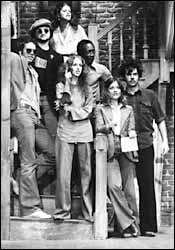TELEVISION 1975

New York City, in the seventies, was out of control—and so was Saturday Night Live. It was dangerous off-camera, too. A friend of mine happened to be watching one of those early-season shows from Lorne Michaels’s director’s chair—he’d been installed there by Michaels himself to be out of harm’s way amid the backstage chaos—when, he remembers, “all of a sudden I’m propelled out of the chair and slammed into the wall. I turn around, and it’s Belushi. It was like looking into the eyes of an animal.” Belushi was just problem-solving, as it happened. He had apparently wanted to put one of his own pals in that chair, noticed that it was taken, and decided simply to remove its current occupant and create the necessary vacancy. This was during the broadcast.
Live from New York, anything could happen, which is why we watched—the original reality TV. If Chevy Chase seemed to be ad-libbing, it’s because he was. If it looked as if Belushi’s samurai sword might have drawn genuine Buck Henry blood that time, it’s because it had.
Lorne Michaels—check in hand—offered the Beatles $3,000 to reunite. John and Paul, by sheer happenstance watching together at the Dakota, thought it would be funny to get in a cab and show up, but in the end they … didn’t. Too tired, Lennon said later.
Elvis Costello, a last-minute replacement for the Sex Pistols (who didn’t make it across the pond for the show; visa problems), famously interrupted “Less Than Zero” to launch into the vitriolic (and unreleased) “Radio, Radio,” whose unvetted lyrics caused the NBC censor in the control room to start screaming, “Cut him off!” Which was funnier than anything any writer could come up with. Subsequently, of course, SNL taught everyone how to be funny.
Would a certain yellowish dysfunctional animated cartoon family exist without SNL? Would their two underachieving, sunken-chested, heh-heh-ing counterparts? Would, for better or worse, much of what’s on MTV, or in Maxim? It’s even an open question whether, had it not been for the sad and glorious ride of spiritual ancestor John Belushi, class upon class of spring breakers would be enjoying the soothing pleasures of a well-fitted beer helmet. Belushi probably never wore one, but the helmet was implicit in his attitude, practically visible.
It was our show, in our city. The cast, overnight demigods, walked among us. They might have lived at 30 Rock virtually round-the-clock, but they did venture out, and not just to Aykroyd and Belushi’s private after-hours Blues Bar at Dominick and Hudson. You (or someone you knew) would see them on the street, or maybe even at a party, or just around: through the steam at the 10th Street Baths; pawing through racks of obscure 45s at specialty-record stores in the middle of the afternoon; at their apartments, where you might be making deliveries while struggling to turn into an overnight demigod yourself; ordering slices with that guy from Devo (sans flowerpot headgear) at your neighborhood pizza dive. They were comedy stars as rock stars, and they were ours—edgy, ubiquitous embodiments of civic pride. And each week, at certain moments, the television show they populated and helped create would unexpectedly lift us out of our chairs, where we’d been laughing comfortably, and slam us against the wall.